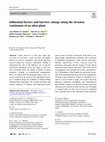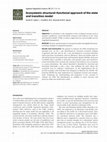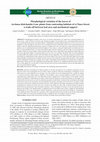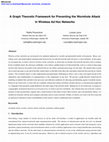Papers by Laura Cavallero
Ecological Processes, Jan 4, 2024

Biological Invasions, Jun 12, 2023
Upon arrival to a new area, alien species have to overcome a series of biotic and abiotic barrier... more Upon arrival to a new area, alien species have to overcome a series of biotic and abiotic barriers to survive, reproduce, and spread and thus, succeed along the invasion continuum. Failing to understand the role of the different sets of barriers and factors operating across the stages of the invasion continuum limit our ability to predict invasion dynamics, leading to misinformed management. Here, we explore how the European plant Cytisus scoparius overcomes the survival and reproductive barriers to establish along the roadsides of Nahuel Huapi National Park (Argentina). We evaluate the direct and indirect influence of climatic and landscape factors, species traits and their interaction with patch cover, plant height, and pollinator visitation rates as proxies of population persistence, plant growth, and reproduction, respectively. Cytisus scoparius cover was positively associated with the length of water shores and urban cover, factors that may relate to the arrival of propagules, new introduction events, and high levels of disturbance. Plant height was positively associated with annual precipitation and mean temperature. Visitation rates positively related to shrubland cover and to a lesser extent to slope, two factors that may influence pollinator availability and long-distance detectability, respectively. However, factors positively affecting survival had no effect (in the case of height) or negative effect (in the case of cover) on visitation rates, probably due to the saturation of the pollinator

Plant Biology, May 1, 2009
Plants show different morphologies when growing in different habitats, but they also vary in thei... more Plants show different morphologies when growing in different habitats, but they also vary in their morphology with plant size. We examined differences in sun‐ and shade‐grown plants of the bromeliad Aechmea distichantha with respect to relationships between plant size and variables related to plant architecture, biomass allocation and tank water dynamics. We selected vegetative plants from the understorey and from forest edges of a Chaco forest, encompassing the whole size range of this bromeliad. Plant biomass was positively correlated with most architectural variables and negatively correlated with most biomass allocation variables. Understorey plants were taller and had larger diameters, whereas sun plants had more leaves, larger sheath area, sheath biomass and sheath mass fraction. All tank water‐related variables were positively correlated with plant biomass. Understorey plants had a greater projected leaf area, whereas sun plants had higher water content and evaporative area. Plasticity indices were higher for water‐related than for allocation variables. In conclusion, there were architectural and biomass allocation differences between sun‐ and shade‐grown plants along a size gradient, which, in turn, affected tank water‐related variables.

Los sistemas silvopastoriles han alcanzado un desarrollo significativo en Sudamérica. En este tra... more Los sistemas silvopastoriles han alcanzado un desarrollo significativo en Sudamérica. En este trabajo evaluamos los enfoques de land sparing (separación entre producción y conservación) y land sharing (integración de producción y conservación) en el contexto de los lineamientos Nacionales para el Manejo de Bosques con Ganadería Integrada (MBGI) en Argentina. Consideramos que la propuesta de MBGI conceptualmente se basa en un enfoque land sharing a escala predial, ya que en un mismo predio se propone mantener la mayor superficie destinada a un uso forestal-ganadero sustentable, con niveles intermedios o moderados de intervención, en donde la base de la producción es el ecosistema natural y áreas más reducidas de intensificación productiva. Para que el MBGI alcance los objetivos de aumentar la productividad conservando los demás servicios ecosistémicos de los bosques nativos, los planes de manejo prediales deben estar contextualizados en relación a su conectividad con el resto del pai...
Actas IX Congreso Internacional de Sistemas Silvopastoriles (Eds.: Chará J., Peri P.L., Rivera J.E., Murgueitio E., Castaño K.). Manizales, Colombia, 6-8 de Septiembre del 2017. p. 2-12, Sep 6, 2017
IV Congreso Nacional de Sistemas Silvopastoriles, Villa la Angostura, Neuquén, 31 de octubre al 2 de noviembre de 2018. p. 64-68., Oct 31, 2018
Ecosystemic structural–functional approach of the state and transition model

Advances in Agroforestry, 2017
The sustainable management of agroforestry landscapes is complex because they are socio-ecosystem... more The sustainable management of agroforestry landscapes is complex because they are socio-ecosystems that integrate biological and socio-productive diversity with spatial-temporal dynamical interactions. Furthermore, agroforestry landscapes provide a variety of ecosystem goods and services at both the farm and global levels, and host thousands of rural people whose livelihoods depend on the forest. Strong dependence on the forest for subsistence strengthens the need to promote their sustainable management. In this chapter, we propose that management practices of Social-Ecological Systems (SES) should be addressed at the landscape scale using a resilience approach to reduce the vulnerability of agroforestry systems to environmental and/or anthropogenic drivers. We examine key properties of farm-level SES components; we demonstrate how they collectively interconnect at the landscape scale and analyze the benefits of resolving social-ecological conflicts at the landscape scale. We highlight a case study in which social-environmental conflicts are increasingly frequent and demonstrate that a resilience management approach at the landscape level should be used as a tool for resolving conflicts. Finally, we conclude that as the search for solutions through decision-making at the farm scale may have indirect and unexpected effects on other SES at the landscape level, replacing a farm-scale perspective with a landscape-scale perspective could increase SES-resilience, reducing their vulnerability to different drivers.

Applied Vegetation Science, 2011
Objective: To contribute to the integration of key ecological concepts such as dynamic equilibriu... more Objective: To contribute to the integration of key ecological concepts such as dynamic equilibrium, critical threshold, resistance and resilience to the 'State and Transition Model' (STM), in order to apply them in a more feasible way for rangeland management. Methods: Review and discussion of conceptual models and applied literature, including examples of rangeland dynamics. Results and Conclusions: We propose to enhance the STM considering two principal axes: (a) the x axis determined by structural ecosystem changes (vegetation and soil) and (b) the y axis determined by ecosystem functions and/or processes (recruitment, rain use efficiency). These axes define what we will call Structural-Functional State and Transition Model (SFSTM). Both axes of SFSTM make it possible to determine and quantify states and transitions, critical thresholds and to evaluate the resistance and resilience of an ecosystem to a given disturbance. The critical threshold is identified by structural and functional thresholds (x and y axes), thus defining the point where the ecosystem loses its resilience. Furthermore, in the supplementary file we provide examples with field data from Patagonia to illustrate the SFSTM. The proposed SFSTM has large implications for rangeland research and management, facilitating the understanding and integration of key concepts to enhance the STM. The identification of variables to assess structure and processes makes the model more useful.
2022 IEEE Biennial Congress of Argentina (ARGENCON)

La mayor parte de los bosques nativos en Argentina cuentan con ganadería. En este contexto, en 20... more La mayor parte de los bosques nativos en Argentina cuentan con ganadería. En este contexto, en 2015 se firma el Convenio Marco Interinstitucional entre los actuales Ministerios de Agroindustria y el de Ambiente y Desarrollo Sustentable de la Nación para la implementación del acuerdo técnico sobre “Principios y Lineamientos Nacionales para Manejo de Bosques con Ganadería Integrada (MBGI)”. El mismo es un plan político-técnico, que permite establecer acuerdos intersectoriales de articulación de herramientas técnicofinancieras, con el fin de optimizar los recursos del estado y la aplicación de los lineamientos por parte de las provincias y los productores. El marco conceptual donde se sustenta el acuerdo técnico MBGI, está basado en la provisión de servicios ecosistémicos por parte de los bosques, y en un esquema de manejo adaptativo para definir las intervenciones. En el presente trabajo se presentan los lineamientos técnicos, los contenidos mínimos de los Planes de Manejo MBGI, el es...
Applied Vegetation Science

Several authors have reported phenotypic plasticity for bromeliad plants growing in contrasting h... more Several authors have reported phenotypic plasticity for bromeliad plants growing in contrasting habitats. Morphological and physiological differences at the leaf level seem to be an adaptation to water and light use, but there is also a compromise between carbon gain and the costs of sustaining static and dynamic loads. We hypothesized that plastic responses to habitat at the leaf level represent a trade-off between photosynthetic area for light capture and mechanical support. In this study, we measured morphological and architectural variables on central and basal leaves of Aechmea distichantha plants from understory and forest edges, as well as anatomical variables for plants from each habitat. Understory plants had longer leaves, larger blade area and greater length/width ratios than forest-edges plants. Blades of understory plants were less erect, less succulent, had thicker fiber tissue surrounding the vascular bundles and higher curvature index than blades of forest-edge plant...

Volcanic eruptions are large-scale natural disturbances, which can negatively affect insect fauna... more Volcanic eruptions are large-scale natural disturbances, which can negatively affect insect fauna and the ecological interactions in which they are involved. The 2011 eruption of the volcanic complex Puyehue Cordón-Caulle (PCC) produced the deposition of 950 million tons of ash on Argentine Patagonia, creating an ash layer of varying thickness. Although experimental studies confirmed that PCC volcanic ash negatively affects survival and behavior in many insect taxa, including bees, the effects of ash deposition on the plant-pollinator interactions (PPI) of this group of insects in natural landscapes remained untested. We evaluated the effect of the gradient of increasing ash layer thickness (0-15cm) on: (1) number of wild bees visiting flowers and total bee richness in 16 raspberry fields after the eruption, (2) number of native (Bombus dahlbomii) and invasive (B. terrestris and B. ruderatus) bumble bees foraging on wild flowers in 10 sites before and after the eruption, and (3) the...

Ecología austral, Aug 1, 2017
RESUMEN. Desarrollamos un modelo de estados y transiciones (MEyT) para el bosque de ñire (Nothofa... more RESUMEN. Desarrollamos un modelo de estados y transiciones (MEyT) para el bosque de ñire (Nothofagus antarctica) en el norte de la Patagonia, con el fin de sintetizar el conocimiento disperso sobre las repuestas de este sistema al manejo silvopastoril. En base a una recopilación bibliográfica, a un taller de expertos seguido por sesiones de consulta y a relevamientos de campo propusimos los estados alternativos e identificamos los disturbios naturales y las prácticas de manejo más comunes que disparan cambios entre estados. Definimos siete estados, 13 transiciones de degradación y cuatro de restauración. Los bosques más íntegros están dominados por ñire y caña (Chusquea culeou) y el estado más degradado lo componen estepas sub-arbustivas de cadillo (Acaena splendens). Los estados intermedios serían los más aptos para el uso silvopastoril (bosque abierto de ñire con caña y pastizal, y bosque de ñire con pastizal), pero tienen una alta inestabilidad con las prácticas de manejo actuales, ya que, a causa de dicho manejo, con el paso del tiempo perderían el componente arbóreo y la cobertura de caña. El pastoreo, la extracción forestal, los incendios y las especies invasoras son los principales factores que disparan las transiciones de degradación. Estos efectos están agravados por la competencia del componente herbáceo con la vegetación arbórea, la mortandad de árboles y de caña, y por la erosión del suelo. La reversión de las transiciones de degradación no se produce de forma natural en el horizonte productivo del predio (~40 años) y requiere del uso de tecnologías como plantación, protección de los plantines de árboles y desarbustado. La identificación de las fases de riesgo en cada estado permite contar con alertas tempranas de deterioro, visualizar los efectos del manejo y orientar las prácticas para mantener la composición y estructura del bosque dentro de los límites que contemplan los aspectos productivo y ambiental.

Un sistema de monitoreo en un proceso sistemático de recolección, evaluación y análisis de la inf... more Un sistema de monitoreo en un proceso sistemático de recolección, evaluación y análisis de la información necesaria para el seguimiento del impacto de la aplicación del Plan de Manejo sobre el sistema predial. Por lo tanto, la evaluación de los ambientes físico, biótico, social y económico durante la aplicación de los tratamientos y las inversiones propuestas, debe permitir la detección temprana de los posibles desvíos en el cumplimiento del plan y las reformulaciones necesarias para corregir las decisiones tomadas. El presente documento presenta los indicadores para planes MBGI a escala predial y propone una metodología de toma de la información y análisis de los indicadores.EEA Santa CruzFil: Alaggia, Francisco. Instituto Nacional de Tecnología Agropecuaria (INTA). Estación Experimental Agropecuaria Manfredi. Campo Anexo Villa Dolores; Argentina.Fil: Alaggia Francisco. Consejo Nacional de Investigaciones Científicas y Técnicas; Argentina.Fil: Cabello, María Julia. Ministerio de Agricultura Ganadería y Pesca (MAGyP); Argentina.Fil: Carranza, Carlos. Instituto Nacional de Tecnología Agropecuaria (INTA). Estación Experimental Agropecuaria Manfredi. Campo Anexo Villa Dolores; Argentina.Fil: Cavallero, Laura. Instituto Nacional de Tecnología Agropecuaria (INTA). Estación Experimental Agropecuaria Manfredi. Campo Anexo Villa Dolores; Argentina.Fil: Daniele, Gonzalo. Ministerio de Ambiente y Desarrollo Sustentable. Dirección Bosques; Argentina.Fil: Erro Velazquez, Melisa. Consejo Nacional de Investigaciones Científicas y Técnicas; Argentina.Fil: Ledesma, Marcela. Instituto Nacional de Tecnología Agropecuaria (INTA). Estación Experimental Agropecuaria Manfredi. Campo Anexo Villa Dolores; Argentina.Fil: Lopez, Dardo Ruben. Instituto Nacional de Tecnología Agropecuaria (INTA). Estación Experimental Agropecuaria Manfredi. Campo Anexo Villa Dolores; Argentina.Fil: Lopez, Dardo Ruben. Consejo Nacional de Investigaciones Científicas y Técnicas; Argentina.Fil: Mussat, Eloisa. Consultora independiente; Argentina.Fil: Navall, Jorge Marcelo. Instituto Nacional de Tecnología Agropecuaria (INTA). Estación Experimental Agropecuaria Santiago del Estero; Argentina.Fil: Peri, Pablo Luis. Instituto Nacional de Tecnología Agropecuaria (INTA). Estación Experimental Agropecuaria Santa Cruz; Argentina.Fil: Peri, Pablo Luis. Universidad Nacional de la Patagonia Austral; Argentina.Fil: Peri, Pablo Luis. Consejo Nacional de Investigaciones Científicas y Técnicas; Argentina.Fil: Rusch, Veronica Elena. Instituto Nacional de Tecnología Agropecuaria (INTA). Estación Experimental Agropecuaria Bariloche. Área Recursos Forestales. Grupo Ecología Forestal; Argentina.Fil: Sabatini, Ángel. Secretaría de Ambiente y Desarrollo Sustentable de Nación. Dirección de bosques. Área socioeconómica; Argentina.Fil: Saravia Sanchez, Juan José. Instituto Nacional de Tecnología Agropecuaria (INTA). Estación Experimental Agropecuaria Santiago del Estero; Argentina.Fil: Uribe Echevarría, Josefina. Instituto Nacional de Tecnología Agropecuaria (INTA). Estación Experimental Agropecuaria Quimilí; Argentina.Fil: Volante, José Norberto. Instituto Nacional de Tecnología Agropecuaria (INTA). Estación Experimental Agropecuaria Salta; Argentina

Advances in Agroforestry, 2017
Silvopastoral systems (SPS) provide a wide range of non-provisioning ecosystem services including... more Silvopastoral systems (SPS) provide a wide range of non-provisioning ecosystem services including carbon (C) sequestration. Well-managed SPS outperform both grasslands/pastures and forests in terms of C by increasing soil and biomass C storage. In this Chapter, C sequestration information from native forests and tree plantations under silvopastoral management in Argentina is provided. C sequestration at the stand level (including importance of soil, stand age, site quality and crown classes on the magnitude of C pools in above- and below-ground biomass and forest floor pools) and landscape level also are provided. Results highlight the importance of SPS as efficient carbon sink ecosystems. In the Chaco region, a mature forest of Aspidosperma quebracho blanco stored 67.6 Mg C ha−1 and this value decreased 17% when managed under the new guidelines of Forest Management Incorporating Livestock due to the reductions in tree density and shrub cover. In the same region, the soil organic C (100 cm depth) stored in a silvopastoral system ( Prosopis alba trees with Chloris gayana pasture) was higher than in an adjacent grazing beef cattle pasture (84.7 vs. 64.6 Mg C ha−1). The magnitude of the impact of implementing SPS on carbon stocks at the regional level across the Dry Chaco depended largely on the landowner’s decisions and on the initial natural vegetation condition. In the Mesopotamia region, SPS became a promising alternative for soil organic carbon storage and wood production simultaneously. In Patagonia, the total C stored in the SPS showed an intermediate value of 148.4 Mg C ha−1 compared with primary forest and adjacent open grasslands. Ponderosa pine plantation added carbon (65–210 Mg C ha−1) to the Festuca pallescens grasslands ecosystem (2.6 Mg C ha−1) which represents the baseline system under study. C storage in SPS is an important mitigation strategy in the context of rapidly increasing level of CO2 in the atmosphere and its potential effect on global climate change.

Acta Oecologica, 2020
Wireless ad hoc networks are envisioned to be randomly deployed in versatile and potentially host... more Wireless ad hoc networks are envisioned to be randomly deployed in versatile and potentially hostile environments. Hence, providing secure and uninterrupted communication between the un-tethered network nodes becomes a critical problem. In this paper, we investigate the wormhole attack in wireless ad hoc networks, an attack that can disrupt vital network functions such as routing. In the wormhole attack, the adversary establishes a low-latency unidirectional or bi-directional link, such as a wired or long-range wireless link, between two points in the network that are not within communication range of each other. The attacker then records one or more messages at one end of the link, tunnels them via the link to the other end, and replays them into the network in a timely manner. The wormhole attack is easily implemented and particularly challenging to detect, since it does not require breach of the authenticity and confidentiality of communication, or the compromise of any host. We present a graph theoretic framework for modeling wormhole links and derive the necessary and sufficient conditions for detecting and defending against wormhole attacks. Based on our framework, we show that any candidate solution preventing wormholes should construct a communication graph that is a subgraph of the geometric graph defined by the radio range of the network nodes. Making use of our framework, we propose a cryptographic mechanism based on local broadcast keys in order to prevent wormholes. Our solution does not need time synchronization or time measurement, requires only a small fraction of the nodes to know their location, and is decentralized. Hence, it is suitable for networks with the most stringent constraints such as sensor networks. Finally, we believe our work is the first to provide an analytical evaluation in terms of probabilities of the extent to which a method prevents wormholes.











Uploads
Papers by Laura Cavallero